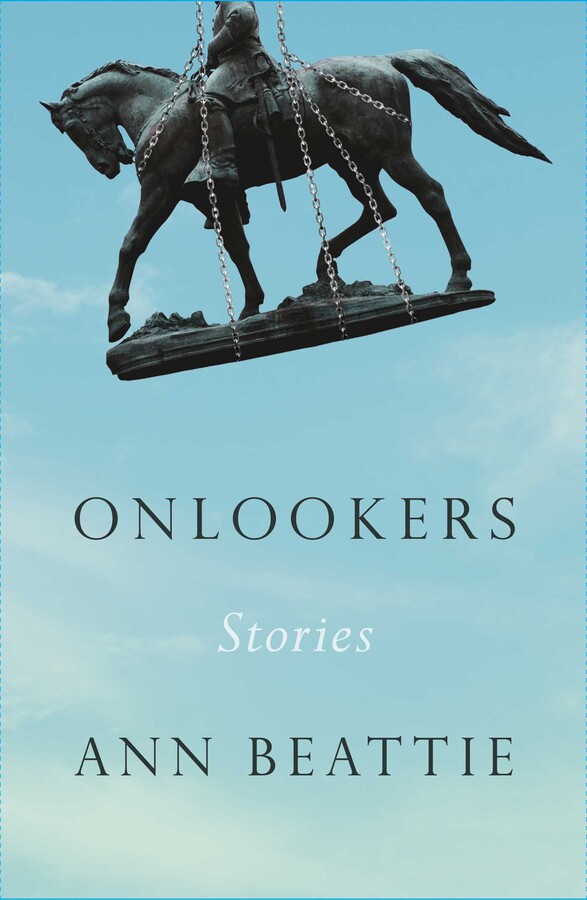It’s been a busy publishing year for Ann Beattie, with her 22nd and 23rd books both coming out in 2023. Her most recent, Onlookers, is set in Charlottesville during the pandemic, and it’s chock-full of local references: The Pointe, Timberlake’s, Orzo, and of course, those statues.
Onlookers is a collection of six stories, with some recurring characters. Each story makes a reference to the statues, either General Robert E. Lee and Traveller, who died from tetanus after stepping on a nail, as one character relates a couple of times in “The Bubble,” or the statue of Lewis and Clark and Sacagawea on West Main Street, visible below other characters’ condo in the Lewis and Clark building in “Nearby.”
Beattie came to Charlottesville in 1975, her first job out of grad school, before she’d published her first novel, Chilly Scenes of Winter, and before there was an MFA program at UVA. “That was started later, by Gregory Orr, who remains a dear friend and who also came to Charlottesville the same year I did,” recalls Beattie in an email interview from Maine.

She returned to UVA in 2000 as the tenured Edgar Allan Poe professor of English and creative literature and taught until 2013, when she resigned after disagreeing with the direction of the university and after a 2010 sabbatical request was denied, according to The Chronicle of Higher Education.
Earlier this year, More to Say, a collection of essays published between 1982 and 2022, came out.
She was in Maine during the Unite the Right rally in 2017, and followed the violent events that unfolded here through newspapers, radio, and TV. However, she says the massing of white nationalists, fascists, and neo-Nazis six years ago did not inspire Onlookers, whose characters mostly are on the periphery of those dark days in Charlottesville history.
“It was not a preconceived idea,” says Beattie. “None of my books, stories or novels, have ever been that. Having lived in Charlottesville for many years, on and off, I still consider it home, in a way, and of course I was deeply troubled by what happened at the Unite the Right rally.”
Beattie weathered the pandemic in Maine, and most of the stories were written in Staunton, where she also has a home. “It’s interesting to me, though, that when I’m not living in a place and it exists largely in my memories and my imagination, I find it easier to write about that place when I’m in a different geographical location.”
She loves the cover of Onlookers, which pictures the Lee statue being hoisted off its pedestal. “Throughout the book, the statues are a refrain, sometimes employed when they’re still in place, other times when they’re gone,” she says. “I think I do see somewhat different meaning, personally, in the statues I mention, though I don’t superimpose my personal thoughts on this very complex issue.”
Beattie is married to artist Lincoln Perry, who endured his own calls for the removal of panels in his Old Cabell Hall mural, “The Student’s Progress,” because of what some considered salacious content. Did being married to a sculptor influence her thoughts about removing the statues?
“I feel that they had to go,” she says, but agrees with Perry that statues shouldn’t be destroyed. “The statues of Lee and Jackson (1917-1919) were intended to reinforce Jim Crow segregation; rather than admitting Secession was about white supremacy, they framed the Civil War as a noble lost cause,” she writes. “Perhaps they were sometimes ‘seen through,’ not just ‘seen,’ in 2017 by some of those who nevertheless felt insulted and diminished by them, which I understand.
“The thought of destroying, not just removing, any artwork makes me unhappy, though. I agree that they should not have stayed where they were. It seems to me that the Lewis and Clark, Sacajawea statue was a different matter, because she was their guide and tracker. Should she have been left out? That would have been a travesty.”
As the title suggests, the characters in the book mostly are onlookers to that tumultuous time, not participants.
“I know people who were there when Heather Heyer was killed,” says Beattie. “I know others, who in turn know others. My book doesn’t really address the rawness and horror of that moment and so many other traumatic moments preceding and following the Unite the Right rally, but if I’d been in the crowd, I’m sure it would have.”
She’s just happy to have Onlookers considered literature. “There are a lot of allusions and motifs in the book, and (to me) that raises questions about why they’re there, and how they work,” she writes. “Many things in the book have their counterpart elsewhere, sometimes for ironic effect, sometimes because life is complicated, and there aren’t easy answers.”
As a veteran of many interviews since being called the voice of her Boomer generation in the ’70s, are there any questions she finds tedious?
“I don’t usually get questions I hate, but I find it boring to be asked supercilious ones like, ‘How do you type with those fingernails?’ Though I’ll even take that, rather than seeing an interview in print that misspells my name.”
